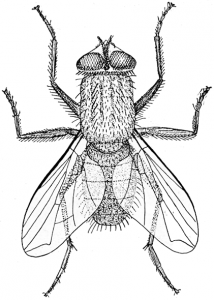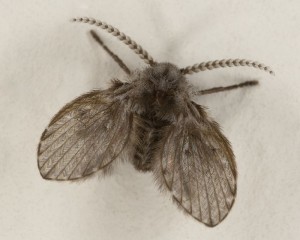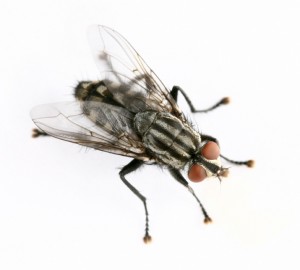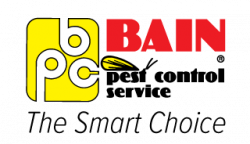Bain’s Fly Control Services – Don’t Let the Nasty Insects Take Over Your Home, Call the Experts
Flies and flying insects can cause harm to your business or home. They can affect your reputation, well-being, and directly impact operations. Flies can pose a significant health risk, can be an unsettling nuisance, and/or project a negative image to clients and friends/family. Amongst pest infestations, fly infestations can be a real challenge to control and prevent.
General Fly Control Services
The most important aspect of fly control is good sanitation and monitoring. The majority of common pest flies feed and breed in/around decaying organic matter, garbage, standing water, etc. So, the first step in eliminating and preventing flies is to practice proper sanitation practices. If you’ve had problems in the past or need to prevent them in the future, setting up traps and monitors, such as fly lights, fly boards, etc, is a great precautionary measure.
Your fly control efforts should really fall into some form of Integrated Pest Management plan. For homeowners, Bain Pest Control offers year round protection with our Home Protection Plan. For business owners, we offer a number of IPM programs to suit any manner of commercial pest control need. It is important to note that restaurants and commercial food companies often face fly control issues, and they are required by law to have some form of IPM plan in place. Don’t wait until you’re confronted by a health inspector to set-up a plan!
Flies are a common nuisance…
It’s important to realize is they are a common pest, and our service technicians have found fly problems in homes, businesses, and industries of all types. There is no shame in having to deal with flies, and the first step to combating an infestation is to identify what type of fly is distressing your business or home.
Types of Flies
The most common flies that plague businesses and homes are the house fly, the fruit fly, and the drain fly.
Fruit Flies
Drosophila Melanogaster, known as the common fruit fly, is found wherever food is prepared, stored, or served. Fermenting fruit and vegetables are the most common food item fruit flies will infest; however they will also be attracted to juices, syrups (and items containing syrup, like soda), and other soft, sweet organic matter.

Once established, fruit flies can further spread to the slime layer in drains–when an infestation occurs in drains, the fruit fly will sometimes be confused with the drain fly. And they can spread quite quickly: fruit flies go from egg to adult in just eight days!
Fruit Fly Facts
- 3 – 4 mm long
- red or black eyes
- typically tan in color, with a black/gray rump
- may be black or gray
- found near old fruits/veggies, or moist areas
Fruit Fly Control & Prevention
In order to eliminate and control fruit flies, the most important step is implementing (or following) proper sanitation practices. First, locate and eliminate fermenting and rotting food sources. These could be on tabletops, cabinets, or less obvious areas like behind/beneath appliances. Second, clean the infested area thoroughly; soap and hot water work fine, but make sure to dry the area well after (fruit flies love moisture). Third, clean out the drains. Fruit flies can spread into the slime layer in the drain, and breed there out of sight (and out of reach) of humans. Take a bucket of soapy water and rinse it down; a little agitation helps, so if you have a brush, scrub the drain pipe down to the bend.
Once you’ve taken care of the above steps, we recommend setting up a monitoring system. This could be using just a few traps in the recently infected area. This will both capture breeding adults and alert you if you still haven’t eliminated the problem. The most effective traps are fly lights, but there are a number of other trap options available.
For severe infestations, an aerosol spray treatment might be needed to quickly and efficiently eliminate fruit flies. This can be paired with a more aggressive trapping system, such as a food attractant trap.
House Flies
 The common house fly, musca domestica, is a nuisance fly and scavenger commonly found in homes and businesses. Infestations can occur rapidly, as a single fly, in one month, can lay upwards of two thousand eggs in waste, garbage, kitchen refuse, and other decaying organic matter. House flies are more prevalent in warmer environments. They can rest and linger on floors, walls, ceilings and prove a nuisance and irritant to residents of homes and the clients of businesses.
The common house fly, musca domestica, is a nuisance fly and scavenger commonly found in homes and businesses. Infestations can occur rapidly, as a single fly, in one month, can lay upwards of two thousand eggs in waste, garbage, kitchen refuse, and other decaying organic matter. House flies are more prevalent in warmer environments. They can rest and linger on floors, walls, ceilings and prove a nuisance and irritant to residents of homes and the clients of businesses.
While primarily a nuisance, house flies are disease carriers. They have been known to transmit cholera, dysentery, salmonella, and worms.
House Fly Facts
- 5 – 7 mm long
- the wingspan of 13 – 15 mm
- the thorax is gray w/ four distinct stripes
- females can lay one hundred eggs at a time
- eggs can hatch in twenty-four hours in warm weather
- egg to adult in about ten days
House Fly Control & Prevention
Like fruit fly control, house fly control begins with good hygiene and sanitation practices. If dealing with a house fly infestation, or trying to prevent one, eliminate potential breeding sites. Dispose of all garbage properly, make sure garbage disposals are flushed of organic matter and clean up areas that have been spilled on. Once an area is sanitized, we recommend using traps to monitor if the infestation was completely removed.
House flies often enter a home or office from the outside. Make entryways are not left open, and that screens on doors and windows are not broken. Check around the exterior of the building and double check that there are no vulnerable areas or unintended openings.
For serious infestations, the above best practices can be paired with an insecticide treatment. A couple of more heavy-duty traps (fly lights, for example) can also be employed to monitor for future infestations.
Drain Flies
 Drain flies are typically found by sinks and drains, as their name implies. While they are not known to transmit human disease, they are a nuisance pest and can signal an unclean environment. They feed on organic matter and sewage and can breed in large numbers in the proper conditions.
Drain flies are typically found by sinks and drains, as their name implies. While they are not known to transmit human disease, they are a nuisance pest and can signal an unclean environment. They feed on organic matter and sewage and can breed in large numbers in the proper conditions.
Drain Fly Facts:
- 1.5 to 5 mm long
- tan body color, light gray coloring, lighter colored wings
- wings may have moth-like or fuzzy appearance
Drain Fly Control & Prevention
As with fruit flies and house flies, the best method of prevention and control for drain flies is good sanitation. By removing breeding sites, you’ll prevent one drain fly from turning into a hundred. Since they feed and breed around decaying organic matter and sewage, clean your kitchen and other areas were food and moisture might sit.
Drain cleaners may not necessarily help, and we recommend hot, soapy water and a brush to scrub the drain. Physically removing organic matter from drains may also be required. After thoroughly cleaning the kitchen or another area, make sure to air it out and dry it thoroughly (drain flies like excessive moisture).
For a more serious situation, consult a pest management professional to see if a treatment plan or insecticide is warranted.
Fly Control Experts
Depending on the flying insect pest that needs to be eliminated, Bain offers various programs and solutions. Services include:
- Flying insect electronic light traps
- Air Curtains
- Biological treatments for drain and fruit fly issues
- Physical trapping
- Chemical residual applications and baiting treatments
- Sanitation consultation and cleaning products to improve and eliminate flying insect breeding areas
We’ve been combating fly infestations for over 80 years, so if you’re under attack, don’t hesitate to contact us! We offer free consultations and can offer you tips and options for dealing with your problem.
Contact us today! Call us at 800-272-3661, or fill out an online request form.

